Starfleet Equipment
Created by Commodore Wilkan Targaryen on Wed Jan 3rd, 2024 @ 10:48pm
Starfleet Equipment
Standard Equipment
Communicator Badge
 The Starfleet Communicator Badge allows for voice communication between the user and other personnel, a starship/starbase, or to a planet via subspace channel. Also known as a combadge, the Communicator is worn by Starfleet personnel on their uniform and incorporates diverse technology to link the user and others including a universal translator.
The Starfleet Communicator Badge allows for voice communication between the user and other personnel, a starship/starbase, or to a planet via subspace channel. Also known as a combadge, the Communicator is worn by Starfleet personnel on their uniform and incorporates diverse technology to link the user and others including a universal translator.To use the Communicator a user will either tap the Starfleet insignia built into the device or activate the unit through voice. The internal software of the Communicator will then connect with the computer systems of the starship, routing the transmission to the appropriate receiver or the Main Computer itself should an information query be needed. Complex subroutines monitor the conversation and analyze the message, monitoring for any voice commands or to connect the user to needed information. Communications will end when the user taps the device, gives an "out" command, or no communication occurs for 30 seconds or longer (but notifies the Communications Officer that no command to close the channel was received for follow up).
While not as advanced as the Universal Translator used by the Ferengi Alliance, Starfleet Communicators are capable of interpreting any conversation it overhears by comparing spoken language to an internal library of over 300 languages. If the Combadge is unable to translate on its own, the device will connect to the Main Computer of the Enterprise through a background connection to assist with analysis. By design the Universal Translator will translate the conversation for both the transmitter and the receiver, allowing two-way communications for both parties.
Starfleet Combadges have an internal range of 60,000 kilometers, but this can be extended to over 100,000 kilometers when supported by the user's mothership. Capable of over 1,000 hours of continued use, a Communicator broadcasts a unique identification signal based upon the user's on file biometrics that Starfleet can use to track the user while they are within range of the spacecraft's sensors as well as to establish a transporter lock.
Personal Access Display Device (PADD)
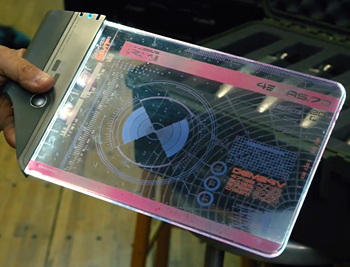 The most common piece of technology in the known galaxy, the Personal Access Display Device (or PADD for short) is a high-capacity hand-held computer terminal used by both civilians and Starfleet personnel alike. To better aid in operations, the current PADD has two functional modes of operation: Desktop and Tablet. While in Desktop Mode, the PADD operates in the same manner as a Desktop Computer. The user would place the device on a tabletop and the internal holoemitters would generate both a monitor and keyboard for the operator to use. While in Tablet mode the PADD would still generate a monitor, but would not generate a separate holographic keyboard. In both modes the PADD could accept verbal instructions.
The most common piece of technology in the known galaxy, the Personal Access Display Device (or PADD for short) is a high-capacity hand-held computer terminal used by both civilians and Starfleet personnel alike. To better aid in operations, the current PADD has two functional modes of operation: Desktop and Tablet. While in Desktop Mode, the PADD operates in the same manner as a Desktop Computer. The user would place the device on a tabletop and the internal holoemitters would generate both a monitor and keyboard for the operator to use. While in Tablet mode the PADD would still generate a monitor, but would not generate a separate holographic keyboard. In both modes the PADD could accept verbal instructions. The only physical component of the PADD used aboard the Starship Enterprise is a portable polyduranium housing that contains a holographic emitter, a positronic memory chip, and a sarium krellide power cell. When in use, the PADD projects a holographic touch sensitive display for the user to access needed information or functions. When sensitive information is accessed, the display will turn opaque to protect confidentiality. Each PADD also incorporates a subspace transceiver that allows real time communications up to 50,000 kilometers away from the unit for up to 5 days on a single charge.
Aboard the Enterprise a PADD may be used to make appointments, communicate, or for recreation purposes. Personnel commonly send and receive reports via their personal PADD and can configure their PADD to interface with any control panel or workstation aboard the ship, provided they have appropriate command clearance. In an emergency a PADD can be used to assume control over any shipboard function, again provided the user has the appropriate command clearance codes. In theory an authorized user could control the entire Starship Enterprise from a single PADD.
Tricorder
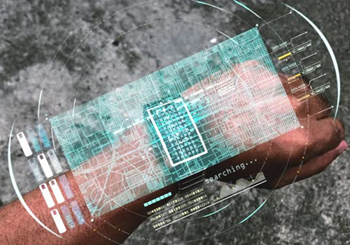 Tricorders are all-purpose, powerful sensory devices used by the Federation, Starfleet, and other organizations. Taking their name from the original name for the device, the Tri-function Recorder, the Tricorder used aboard the Enterprise is a wearable tool instead of being a hand-held unit like previous models. The Tricorder is constructed of durable materials and is also smaller than its predecessors with the device's communications, circuits, energy cell, processors, and sensors all being housed in a space not much larger than a 21st Century Smart Watch.
Tricorders are all-purpose, powerful sensory devices used by the Federation, Starfleet, and other organizations. Taking their name from the original name for the device, the Tri-function Recorder, the Tricorder used aboard the Enterprise is a wearable tool instead of being a hand-held unit like previous models. The Tricorder is constructed of durable materials and is also smaller than its predecessors with the device's communications, circuits, energy cell, processors, and sensors all being housed in a space not much larger than a 21st Century Smart Watch. The Tricorder's base controls were built into a small emitter diode located on the upper surface of the Tricorder's wrist band. Control inputs for data and scanning functions dominated the main interface; however, there was no dedicated monitor screen to view information. Data analysis and review was provided through an interface projected from a built-in holographic emitter diode located on the upper surface of this control panel. Based upon existing technology in use since the Dominion War, the flat-screen array of omnidirectional holodiodes translate data from the Tricorder's sensors into a three-dimensional holographic image that floats over the user's wrist, highlighting items of interest, by default; however, the unit was also capable of projecting a two-dimensional interface. The control inputs of the unit were replicated on the holographic interface for ease of usage and provided the user with additional functions to choose from outside those available through the tactile interface on the Tricorder's surface. Internal subspace communications equipment - similar to that of the Communicator - built into the interface allows the Tricorder to connect with other Tricorders, the user's mothership, or even alien computer networks to transmit and receive data. In a true emergency a Tricorder could perform a data dump to its home base, transmitting the entirety of its database in less than a second.
Powered by an internal sarium krellide power cell, the Tricorder can operate for up to 1,000 hours of intermittent routine use or for 36 hours of continuous usage. The powerful, miniaturized sensor arrays of the device are built into the wristband of the unit and have an effective range of 5 kilometers for long-range scans and 50 meters for short-range scans. Capable of detecting and analyzing a variety of phenomena, readings are compared to detailed datafiles stored within the memory core of the Tricorder to aid in analysis of a subject, allowing for the identification of energy sources, life-forms, or other materials through comparison and inference. Routine scans can be completed nearly instantaneously while more concentrated, in-depth analysis of a subject can take up to an hour to complete. An expert in multitasking, a Tricorder can still complete routine investigations while conducting complex analysis. While advanced the Tricorder is not infallible as ionic and electromagnetic interference can disrupt or even prevent scans from occurring or decrease the Tricorder's effective range.
Tricorder Scan Types | ||
|---|---|---|
| Biological | A Tricorder can identify the species of a lifeform (if known to the Federation) or the type of lifeform as well as the lifeform's health status. | A Tricorder will detect and track the position of lifeforms within scanning range. |
| Geological | The Tricorder can locate caves, small concentrations of mineral deposits, or concealed geological features. The chemical composition of a subject can also be determined. | Large caves, significant mineral deposits, and large geological features can be detected. |
| Meteorological | Scans will determine the atmospheric composition of the local area and small-scale energy sources. | Large energy sources within range will be detected by this scan type, local weather patterns analyzed, and interference identified. |
Type I Hand Phaser
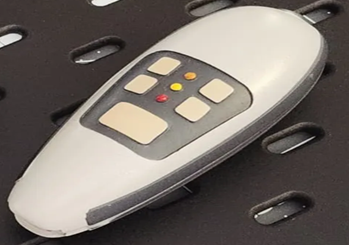 Phasers, short for PHASed Energy Rectification, are the standard defensive weapon used by Starfleet and are constructed of nano-bound polyduranium and other synthetic materials. Assigned to all Starfleet personnel, planetary security forces on Federation worlds, and even some civilians, Type I Phasers are designed to be discreetly carried during away missions, diplomatic assignments, and during routine operations and are the smallest personal weapon available.
Phasers, short for PHASed Energy Rectification, are the standard defensive weapon used by Starfleet and are constructed of nano-bound polyduranium and other synthetic materials. Assigned to all Starfleet personnel, planetary security forces on Federation worlds, and even some civilians, Type I Phasers are designed to be discreetly carried during away missions, diplomatic assignments, and during routine operations and are the smallest personal weapon available.Employing a rapid nadion effect (producing highly energetic, short-lived particles) and superconducting crystals to emit powerful energy beams, a Phaser has both tactical applications and can even be used as a tool. To comply with local planetary regulations, the Type I features software restricting the weapon to the stun setting; however, an authorized officer can override this restriction to allow the kill setting to be used. While the Type I is limited to firing energy beams and does not have a pulse mode, the Starfleet model incorporates the option to overload if enough energy is available. An optional modification allows the Type I to fire beams more quickly than the standard model, but this reduces the accuracy of the weapon.
Containing a single prefire chamber, the Type I Phaser does not share the pistol design of the larger Type II Phaser and cannot be merged with the larger unit. Featuring a unibody construction, the Phaser was designed to be durable and was molded to comfortably fit in a humanoid hand. Essential components are all stored within the body of the weapon, including an internal sarium krellide power cell providing 100 charges prior to needing recharged through the EPS Taps aboard the Enterprise. The trigger to fire the Phaser was located on the top of the weapon at the base of a small operators panel capable of controlling the power level and showing the remaining charges until the ammunition is depleted.
Phaser Type I Power Settings | |||
|---|---|---|---|
| 1 | Stun | 2 | Stun a Human for 15 minutes or a Klingon for 5 minutes. |
| 2 | Kill | 10 | Kill a humanoid. |
| Overload | 50 | Vaporizes all objects within 5 meters of the Phaser. | |
Uniform
 Starfleet Uniforms are worn by individuals serving in the Federation Starfleet. Designed for comfort and durability in the most extreme environments, Starfleet uniforms facilitate the wearers' needs as both scientists and researchers, as well honoring Starfleet's military role. All personnel are expected to abide by the Starfleet Uniform Code, though special exceptions can be made to honor aspects of an individual's cultural heritage.
Starfleet Uniforms are worn by individuals serving in the Federation Starfleet. Designed for comfort and durability in the most extreme environments, Starfleet uniforms facilitate the wearers' needs as both scientists and researchers, as well honoring Starfleet's military role. All personnel are expected to abide by the Starfleet Uniform Code, though special exceptions can be made to honor aspects of an individual's cultural heritage.While the color scheme had varied over time, Starfleet uniforms are classified by color with the current colors in practice:
- Command: The Command Division is responsible for the administration of starships, starbases, and space stations. These personnel are distinguished by red coloration.
- Operations: The Operations Division is the backbone of Starfleet and incorporates the engineering, operations, and security departments. This group is responsible for technological innovation and for maintaining and defending the Federation and typically wear uniforms with gold coloration.
- Science: The Sciences Division is the heart of Starfleet and comprises members of the exploratory, medical, and mental health departments within the fleet. Science personnel are identified by uniforms with teal coloration.
- Service: The Service Division fulfills all support roles within Starfleet and are identified by uniforms with silver coloration.
Engineering Equipment
Anti-Grav Unit
 The Anti-Grav Unit, also known as an Anti-Grav Lift or Anti-Grav Sled, were a series of specialized devices that were used to carry objects that were considered too heavy to lift manually. In usage since the early 23rd Century, a variety of Anti-Gravity devices are currently in use aboard Federation Starships including the Enterprise with the majority of the devices being used in the ship's engineering spaces. Nonetheless, Anti-Grav Sleds are also available in the medical section for use as stretchers.
The Anti-Grav Unit, also known as an Anti-Grav Lift or Anti-Grav Sled, were a series of specialized devices that were used to carry objects that were considered too heavy to lift manually. In usage since the early 23rd Century, a variety of Anti-Gravity devices are currently in use aboard Federation Starships including the Enterprise with the majority of the devices being used in the ship's engineering spaces. Nonetheless, Anti-Grav Sleds are also available in the medical section for use as stretchers.All Anti-Gravs aboard the Enterprise operate by producing antigraviton fields that either reduce or negate the effects of gravity. Considered more effective on Starbases and Starships than in natural gravity, the Anti-Grav supports a series of graviton emitters on the underside of the device that interact with the gravitational field to, essentially, make the items being transported essentially weightless, while retaining their mass.
Engineering Kit
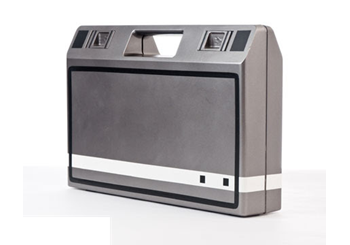 Starfleet Engineering Kits were specialized equipment cases that stored devices that an engineer could use to perform repair and maintenance assignments. Commonly used by an Engineer while on an away mission, Engineering Kits were also stored in bulk aboard Starfleet bases and vessels for crisis and emergency response missions.
Starfleet Engineering Kits were specialized equipment cases that stored devices that an engineer could use to perform repair and maintenance assignments. Commonly used by an Engineer while on an away mission, Engineering Kits were also stored in bulk aboard Starfleet bases and vessels for crisis and emergency response missions. Each Engineering Kit was designed to be compact and easy to carry via the attached handle atop the unit, with every Engineer being assigned an Engineering Kit upon reporting for duty. Designed with durability in mind, Starfleet Engineering Kits use polyduranium foam to protect the specialized equipment inside of them from harm while on assignment. While the Engineering Kit contains basic tools, they are indispensable for the Engineers using them and incorporate an internal processor to aid in maintenance troubleshooting.
Engineering Kit Contents | |
|---|---|
| Engineering Tricorder Peripheral | The Engineering Tricorder utilizes enhanced sensors and analysis software to assist with repair and diagnostics. |
| Gravitic Caliper | Gravitic calipers reroute plasma flow, isolating components without disrupting power to an entire system. |
| Hyperspanner | A Hyperspanner is used to repair relays and circuits, alter and realign systems, and attach or unfasten screws, bolts, and other fasteners. |
| Magnetic Probe | Magnetic probes regulate warp core antimatter flows to expedite repairs. |
| Plasma Torch | An all-purpose cutting tool, a Plasma Torch uses a super-heated, ionized beam to cut through materials. |
Engineering Tricorder Peripheral Module
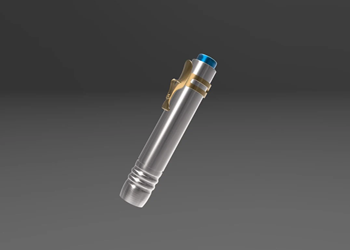 While the standard issue Tricorder is all-purpose, powerful sensor devices used by Starfleet and other organizations, there are times where specialty scans and more comprehensive analysis are required as part of an investigation. To better support Starfleet's diverse mission profile, Starfleet Logistical Support has developed specialized Tricorder models to perform enhanced analysis and investigation through the inclusion of a specialty Peripheral Module.
While the standard issue Tricorder is all-purpose, powerful sensor devices used by Starfleet and other organizations, there are times where specialty scans and more comprehensive analysis are required as part of an investigation. To better support Starfleet's diverse mission profile, Starfleet Logistical Support has developed specialized Tricorder models to perform enhanced analysis and investigation through the inclusion of a specialty Peripheral Module. The Tricorder Peripheral Module is a sensor probe that connects with a Tricorder through a remote secure wireless connection, allowing the user to conduct more intensive scans than available with a standard Tricorder. Operated within a minimum distance of five meters from the subject, the closer the user gets to the target the more enhanced scans can be completed. The peripheral can be directly attached to the underside of the Tricorder while not in usage, but must be disconnected from the Tricorder and held in the user's hand to conduct a scan.
The Engineering Tricorder is a specialized Peripheral Module that incorporates a high-resolution sensor probe that can collect precise information about a technological device. After obtaining scan data, the Engineering Tricorder would run an analysis of the information and cross reference the findings with details from its extensive internal database, which includes information on all known ships and devices encountered by the Starfleet Corps of Engineers. Following its review, the Engineering Tricorder would then provide a recommended course of action to resolve a concern.
Field Modulator
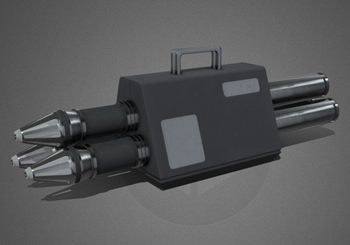 Following the Attack on Mars in 2385 the United Federation of Planets and Starfleet experienced a shortage in equipment, personnel, and resources. To combat this, the Starfleet Corps of Engineers were tasked with making equipment construction and deployment more efficient in light of reduced resource availability. The current generation of Field Modulator was one technology that benefitted from the reduced resources, leading to the combination of multiple devices into one single package.
Following the Attack on Mars in 2385 the United Federation of Planets and Starfleet experienced a shortage in equipment, personnel, and resources. To combat this, the Starfleet Corps of Engineers were tasked with making equipment construction and deployment more efficient in light of reduced resource availability. The current generation of Field Modulator was one technology that benefitted from the reduced resources, leading to the combination of multiple devices into one single package. Tripodal in design, the Field Modulator is roughly 1.5 meters in height and is constructed of lightweight materials for easy transport. In keeping with its original purpose, the Field Modulator has multiple functions related to forcefield operations. As a Field Modulator, the device is able to assist with disabling forcefields encountered by Starfleet personnel. Originally designed for emergency response, a group of Field Modulators are placed adjacent to the forcefield and are used to scan for the resonance frequency of the target forcefield. Once the forcefield's frequency is determined, the Modulator will emit an interference pattern to disable the field and allow personnel to pass through. While capable, the Field Modulator is limited in function to standard forcefields and are ineffective against deflector shields.
In addition to their abilities in deactivating a forcefield, the Field Modulator can also create one. Typically, Field Generators are large, bulky emplacements that are not designed to be mobile; however, with the number of threats encountered by Starfleet in the 24th and 25th Centuries, Portable Force Field Generators have grown in popularity. Utilizing a group of Field Modulators, personnel will place the Field Modulators based upon the needs of the user. In their default setting, the Field Modulators will produce an invisible, airtight forcefield wall connecting the Field Modulators to block access. If needed, the Modulators can be used isolate an area by creating a forcefield dome between the devices. Individuals wearing approved Combadges or Tricorders are able to pass through the field with ease while still maintaining the quarantine seals created by the forcefield dome.
Aside from functions involving forcefields, the Field Modulators are also used to assist in Transporter operations. Typically, Field Modulators are used as Pattern Enhancers. In this mode of operation, the Field Modulator can boost and stabilize transporter signals through interference. Using a minimum of three Field Modulators, the devices link to create a perimeter wherein the Transporter can lock onto a target and beam them through the interference. Conversely, Field Modulators can also be set to serve as Transport Inhibitors to block a Transporter from functioning. When employed as an inhibitor, the Field Modulators release harmless tetryonic radiation to cause a Transporter's annular confinement beam to dissipate, preventing Transporter Lock. The Field Modulator could also be used as a test cylinder to test a Transporter's functioning, using a varietal molecular matrix to simulate organic and inorganic compounds.
Replicator Multitool (Engineering)
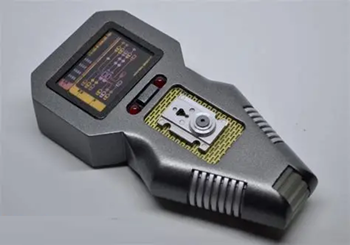 Originally created in 2371, the Replicator Multitool was designed to be able to recreate almost any small hand-held tool used by citizens of the United Federation of Planets. Initially, the Replicator Multitool was limited to civilian usage as the Starfleet Corps of Engineers had ruled that the device was unreliable when exposed to certain radiations; however, Starfleet did allow the Multitool to be included in emergency response kits for humanitarian purposes. Nonetheless, following the Attack on Mars, as the Federation and Starfleet faced severe resource shortages in the late 24th Century, Admiral Edward Jellico chose to override the restrictions on Replicator Multitools and approved the devices for use within Starfleet.
Originally created in 2371, the Replicator Multitool was designed to be able to recreate almost any small hand-held tool used by citizens of the United Federation of Planets. Initially, the Replicator Multitool was limited to civilian usage as the Starfleet Corps of Engineers had ruled that the device was unreliable when exposed to certain radiations; however, Starfleet did allow the Multitool to be included in emergency response kits for humanitarian purposes. Nonetheless, following the Attack on Mars, as the Federation and Starfleet faced severe resource shortages in the late 24th Century, Admiral Edward Jellico chose to override the restrictions on Replicator Multitools and approved the devices for use within Starfleet.The Replicator Multitool uses holographic and microreplicator technology to recreate any tool preprogrammed into the device's database. Early devices were limited to basic tools due to the storage limitations of isolinear technology, but the integration of positronic chips in the 25th Century expanded the available tool library extensively. The user will select the desired tool using the touchscreen display built into the surface of the device. Once selected, forcefield projectors and miniaturized replicator equipment within the handle of the device will generate the device within five seconds, with the Multitool serving as tool's handle.
The Multitool continually draws energy from the internal sarium krellide power cell, which can lead high-energy tools to overwhelm the power supply of this small device during prolonged usage. Additionally, despite the presence of a positronic chip managing the device, limitations on overall memory have necessitated that specialized memory chips be created that store the programmed patterns related to engineering or medical purposes.
Common Engineering Replicator Multitool Devices | |
|---|---|
| Coil Spanner | The Coil Spanner is used to make phase adjustments to equipment. |
| Field Destabilizer | Capable of destabilizing forcefields, the Field Destabilizer determines the forcefield's harmonics and temporarily overwhelms them. |
| Gravitic Caliper | Gravitic calipers reroute plasma flow, isolating components without disrupting power to an entire system. |
| Hyperspanner | A Hyperspanner is used to repair relays and circuits, alter and realign systems, and attach or unfasten screws, bolts, and other fasteners. |
| Magnetic Probe | Magnetic probes regulate warp core antimatter flows to expedite repairs. |
| Maintenance Jack | A Maintenance Jack is used to remove security braces or divert power inside an EPS junction. |
| Micro-Optic Drill | A precise hand tool, the Micro-Optic Drill can drill small holes through common materials. |
| ODN Recoupler | An ODN Recoupler is used to modify Optical Data Network circuitry. |
| Phase Decompiler | The Phase Decompiler is used to work on plasma distribution networks. |
| Plasma Torch | An all-purpose cutting tool, a Plasma Torch uses a super-heated, ionized beam to cut through materials. |
| Sonic Driver | The Sonic Driver is a general-purpose tool used to either attach or remove screws, bolts, and other fasteners. |
Medical Equipment
Hypospray
 The Hypospray is a medical device that is used to either extract or inject liquids into a humanoid body.
The Hypospray is a medical device that is used to either extract or inject liquids into a humanoid body.The current Hypospray design used by Starfleet Medical was introduced in the early 2430s and is primarily used to administer medication noninvasively. A practitioner would select a small cylindrical vial of medication for administration and would insert the medication into the base of the Hypospray. The user would then adjust the nozzle at the opposite end of the device to set the dosage level and the operator would press the nozzle against the patient's skin, with the carotid artery on the neck or the upper arm used for injection. The Doctor injected the medication by tapping the base of the vial, using compressed air to transfer the injectant from the device into the subdermal layer below the skin of the body or the artery without penetrating the skin. As the skin of the patient was not punctured during use, the risk of infection or pain at the injection site is minimal and the medication could be used on multiple patients without the risk of spreading blood-borne illnesses to others.
In the late 24th Century, Starfleet Medical adapted the Hypospray to allow a Doctor to extract blood from a patient using a similar procedure as to inject a medication into the body. The user will place an empty vial into the device and adjust the settings on the exterior nozzle to prepare the device to extract the blood, other liquid, or even air into the vial for analysis. Once setup is complete, the Doctor will place the injector against the patient - commonly selecting a vein - and tap the vial to begin the extraction. Once complete the vial may then be removed from the Hypospray and sent for analysis.
Common Medications | |||
|---|---|---|---|
| Alkysine | Neurostimulant | ||
| Anesthezine | Anesthetic | ||
| Anetrizine | Anesthetic | ||
| Arithrazine | Treats Radiation Exposure | ||
| Axonol | Anesthetic | ||
| Cervaline | Antirejection medication | ||
| Chloromydride | Cardiostimulant | ||
| Cordrazine | Stimulant | ||
| Corophizine | Antibiotic | ||
| Cortolin | Pulmonary Stimulant | ||
| Delactovine | Stimulant | ||
| Dermaline | Burn Treatment | ||
| Dexalin | Counteracts Oxygen Deprivation | ||
| Dylovene | Antitoxin | ||
| Hydrocortiline | Pain Relief | ||
| Hyronalin | Treats Radiation Exposure | ||
| Inaprovaline | Cardiostimulant | ||
| Kayolane | Sedative | ||
| Lectrazine | Cardiovascular and Renal Stabilizer | ||
| Melorazine | Sedative | ||
| Retinax | Optical Stimulant | ||
| Terakine | Pain Relief | ||
| Tri-Cordrazine | Stimulant | ||
| Tri-Ox Compound | Pulmonary Stimulant | ||
| Vertazine | Counteracts Vertigo | ||
Medical Kit
 Starfleet Medical Kits, also known as Med Kits or a Med Pouch, were specialized equipment cases that stored devices that a medical professional could use to perform routine and some emergency medical treatments away from a Sickbay. Commonly used by a Medical Officer while on an away mission, Med Kits were also stored in bulk aboard Starfleet bases and vessels for crisis and emergency response missions.
Starfleet Medical Kits, also known as Med Kits or a Med Pouch, were specialized equipment cases that stored devices that a medical professional could use to perform routine and some emergency medical treatments away from a Sickbay. Commonly used by a Medical Officer while on an away mission, Med Kits were also stored in bulk aboard Starfleet bases and vessels for crisis and emergency response missions. The primary tool loaded in the Med Kit was a Replicator Multitool. The Replicator Multitool was able to temporarily replicate any preprogrammed medical device. A Medical Tricorder Peripheral Module that could be linked to a Tricorder was included to allow for enhanced diagnosis while a Hypospray allowed for medication administration. Six vials of medication were included for treatment as well to help stabilize a patient until they could return to the Enterprise. Medications available in the pouch included the anesthetic Anesthezine, pain reliever Terakine, radiation medication Hyronalin, sedative Melorazine, as well as stimulants Cordrazine and Tri-Ox.
Medical Tricorder Peripheral Modules
 While the standard issue Tricorder is all-purpose, powerful sensor devices used by Starfleet and other organizations, there are times where specialty scans and more comprehensive analysis are required as part of an investigation. To better support Starfleet's diverse mission profile, Starfleet Logistical Support has developed specialized Tricorder models to perform enhanced analysis and investigation through the inclusion of a specialty Peripheral Module.
While the standard issue Tricorder is all-purpose, powerful sensor devices used by Starfleet and other organizations, there are times where specialty scans and more comprehensive analysis are required as part of an investigation. To better support Starfleet's diverse mission profile, Starfleet Logistical Support has developed specialized Tricorder models to perform enhanced analysis and investigation through the inclusion of a specialty Peripheral Module. The Tricorder Peripheral Module is a sensor probe that connects with a Tricorder through a remote secure wireless connection, allowing the user to conduct more intensive scans than available with a standard Tricorder. Operated within a minimum distance of five meters from the subject, the closer the user gets to the target the more enhanced scans can be completed. The peripheral can be directly attached to the underside of the Tricorder while not in usage, but must be disconnected from the Tricorder and held in the user's hand to conduct a scan.
One of two specialized Peripheral Modules available for Medical Practitioners, the Medical Tricorder incorporates biosensors capable of collecting detailed information about a biological specimen, providing detailed scans of an entire specimen or focused results on a specific location on the life-form. Once data was obtained, the Medical Tricorder would run an analysis of the information and cross reference the findings with details from its internal database. With extensive files on anatomy, disease, illness, and infection, the Medical Tricorder would then provide a recommended course of treatment for a patient. While they were often the first tool that a Starfleet doctor would use when assessing a patient, Medical Tricorders were less accurate while studying a deceased subject.
For Counseling purposes, the Psychotricorder is a specialized Peripheral Module designed to aid a Psychologist in analyzing a patient's mental health. The Psychotricorder operates by scanning specific brain wave patterns during questioning, comparing the information obtained against internal records to come to a diagnosis and treatment for mental ailments and disorders. Requiring a trained operator and Counselor to administer directed questioning, the Psychotricorder further possessed a hypnosis-assist subroutine, as well as subroutines for lie-detection and amnesia analysis. While advanced, the Psychotricorder is not infallible and requires a willing participant as its results can be unreliable.
Replicator Multitool (Medical)
 Originally created in 2371, the Replicator Multitool was designed to be able to recreate almost any small hand-held tool used by citizens of the United Federation of Planets. Initially, the Replicator Multitool was limited to civilian usage as the Starfleet Corps of Engineers had ruled that the device was unreliable when exposed to certain radiations; however, Starfleet did allow the Multitool to be included in emergency response kits for humanitarian purposes. Nonetheless, following the Attack on Mars, as the Federation and Starfleet faced severe resource shortages in the late 24th Century, Admiral Edward Jellico chose to override the restrictions on Replicator Multitools and approved the devices for use within Starfleet.
Originally created in 2371, the Replicator Multitool was designed to be able to recreate almost any small hand-held tool used by citizens of the United Federation of Planets. Initially, the Replicator Multitool was limited to civilian usage as the Starfleet Corps of Engineers had ruled that the device was unreliable when exposed to certain radiations; however, Starfleet did allow the Multitool to be included in emergency response kits for humanitarian purposes. Nonetheless, following the Attack on Mars, as the Federation and Starfleet faced severe resource shortages in the late 24th Century, Admiral Edward Jellico chose to override the restrictions on Replicator Multitools and approved the devices for use within Starfleet.The Replicator Multitool uses holographic and microreplicator technology to recreate any tool preprogrammed into the device's database. Early devices were limited to basic tools due to the storage limitations of isolinear technology, but the integration of positronic chips in the 25th Century expanded the available tool library extensively. The user will select the desired tool using the touchscreen display built into the surface of the device. Once selected, forcefield projectors and miniaturized replicator equipment within the handle of the device will generate the device within five seconds, with the Multitool serving as tool's handle.
The Multitool continually draws energy from the internal sarium krellide power cell, which can lead high-energy tools to overwhelm the power supply of this small device during prolonged usage. Additionally, despite the presence of a positronic chip managing the device, limitations on overall memory have necessitated that specialized memory chips be created that store the programmed patterns related to engineering or medical purposes.
Common Medical Replicator Multitool Devices | |
|---|---|
| Anabolic Protoplaser | An Anabolic Protoplaser is designed to repair torn veins and arteries by uniting the nerves and muscle fibers. |
| Autosuture | Using specialized molecular bonding technology, an Autosuture is used to heal physical injuries. |
| Dermal Regenerator | By stimulating natural healing processes Dermal Regenerators accelerate the repair of injuries and mild infections. |
| Exoscalpel | Exoscalpels use a low-power cutting beam to cleanly cut through flesh, bone, or other organic material to a predetermined depth. |
| Micro-suture | A micro-suture was a microscopic suture used to connect two separate things. |
| Osteo Regenerator | An Osteo Regenerator is used to repair bone fractures. |
| Thrombic Modulator | This Thrombic Modulator changes the coagulation ratio of blood within the body. |
| Tri-laser Connector | Used to treat neurological trauma, the Tri-laser Connector reconstructs damaged brain tissue. |
| Vascular Regenerator | A Vascular Regenerator is used to repair blood vessels and stop bleeding. |
Scientific Equipment
Camouflage Hologenerator
 Designed as the successor to the Isolation Suits worn by First Contact Specialists, the Camouflage Hologenerator is a portable, wearable hologenerator that can be used by Scientists to remain hidden from native populations under observation. Unlike Cloaking Technology, Camouflage Hologenerators are not able to completely hide their user due to intergalactic treaty and are detectable by modern sensors; however, primitive sensor technologies are unable to penetrate the holographic field.
Designed as the successor to the Isolation Suits worn by First Contact Specialists, the Camouflage Hologenerator is a portable, wearable hologenerator that can be used by Scientists to remain hidden from native populations under observation. Unlike Cloaking Technology, Camouflage Hologenerators are not able to completely hide their user due to intergalactic treaty and are detectable by modern sensors; however, primitive sensor technologies are unable to penetrate the holographic field. Built into a wearable bracelet, the Camouflage Hologenerator consists of a web of omni-directional holodiodes that are used to project a holographic image to conceal the operator from visual detection. Sound dampening technology absorbs sounds emanating from the user and EM emissions are absorbed and scattered to prevent detection from primitive technologies. The onboard processor built into the generator continually monitors the area through dedicated sensor analysis, continually updating the image generated by the holodiodes to prevent visual detection. An internal transponder broadcasts signals to the operator's mothership, providing real-time location information.
Should the user need to camouflage themselves and others, the device is capable of being removed and placed in a centralized location to generate a 10 meter dome around the unit; however, such operation is not as effective as when used to conceal a single person. While used by Starfleet, the equipment has recently been approved for civilian usage. In the short period that this has occurred, Starfleet Security has already encountered smugglers who have upgraded the technology with anti-sensor technologies that, essentially, transform the hologenerator into a cloaking device.
Holographic Imager
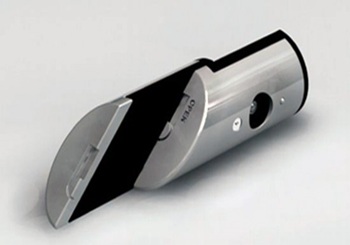 The Holographic Imager, or Holocamera, was a device that used recorded holo-scans to reproduce an event in holographic form. While a common sight at recreational events, Starfleet Science personnel frequently use Holocameras as part of their investigations.
The Holographic Imager, or Holocamera, was a device that used recorded holo-scans to reproduce an event in holographic form. While a common sight at recreational events, Starfleet Science personnel frequently use Holocameras as part of their investigations.While holographic imaging did not come into its own until the 24th Century, the operating process of the Holocamera is essentially the same as the earliest photographic cameras built on Earth in the 19th Century. Capable of taking nearly unlimited still images and thousands of hours of three-dimensional video, the user operated the Holo Imager by pointing the device at the subject to be recorded and starting the recording process, either by pressing the record button, using the built-in timer, or giving a verbal instruction. Internal sensors would then record the information onto the built in processor chip to allow for later playback. The Holocamera normally recorded the subject in standard spectrums, but the device could be modified to serve as a scanning device where the images could be later rendered in full detail by holoemitters.
Portable Electron Microscope
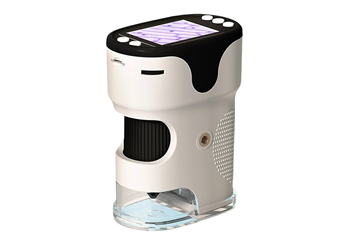 Deployed by specialist personnel who are trained in their operation, the Portable Electron Microscope is used in scientific investigations to examine subatomic particles.
Deployed by specialist personnel who are trained in their operation, the Portable Electron Microscope is used in scientific investigations to examine subatomic particles. Often paired with a Tricorder, the Portable Electron Microscope used aboard the Enterprise uses cutting edge technology to analyze the sub-atomic particles and quantum structures of a subject. Utilizing a process known as high-resolution electron microscopy, the device allows multiple different diffracted beams to travel through the objective aperture, which later interfere, leading to images which represent the atomic structure of the material. Depending upon how thick the samples are and the aberrations of the microscope, these images can either be directly interpreted in terms of the positions of columns of atoms, or require a more careful analysis using calculations of the multiple scattering of the electrons and the effect of the contrast transfer function of the microscope.
Remote Drone
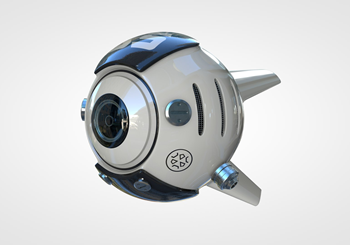 Originally employed by civilian merchants, the Remote Drone was created to allow investigation of a potentially dangerous world without having to leave the safety of a vessel.
Originally employed by civilian merchants, the Remote Drone was created to allow investigation of a potentially dangerous world without having to leave the safety of a vessel.Powered by an internal sarium krellide power cell, the Remote Drone was a fully automated device that would allow its user to explore a world without experiencing direct risk to their own safety. Incorporating the same sensors as a standard issue Tricorder, the Remote Drone would allow the user to take detailed scans of the surrounding area to learn about the environment and locate any resources of interest. Internal communications systems allow for real-time communication between the operator and anyone encountered by the drone during its assignment. By default the user would communicate through two-way audio communication, but an internal holographic emitter diode was also available to allow for holographic communication or to hide the device from the locals.
Unarmed, the Remote Drone incorporates a small antigravity propulsion unit within its structure that can propel the device in either atmosphere or vacuum and the Drone's shell is composed of a hyper-conducting material allowing for smooth, self-propelled flight in any atmosphere. When not controlled from its mothership, the Remote Drone can be controlled by its user from specialized software installed into the user's PADD. As needed the drone can be placed into patrol mode, automatically following a predetermined route and reporting any findings back to its home base.
Sample Container
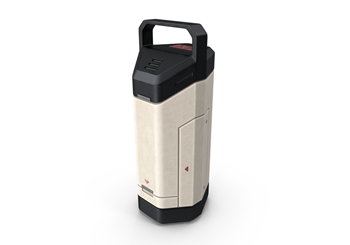 Starfleet issue Sample Containers, also known as Containment Vessels, were a type of container that was used by the Federation to hold matter or energy for investigation by Science personnel. Capable of managing a variety of samples, each sample container can meet a variety of specifications and could be reinforced with both containment and stasis fields to maintain the stability of its contents.
Starfleet issue Sample Containers, also known as Containment Vessels, were a type of container that was used by the Federation to hold matter or energy for investigation by Science personnel. Capable of managing a variety of samples, each sample container can meet a variety of specifications and could be reinforced with both containment and stasis fields to maintain the stability of its contents.Initially, Starfleet Sciences employed a variety of specialized Sample Containers during exploration missions including Biological Sample Containers, Containment Cylinders, and standard Sample Containers to name a few. Following the Attack on Mars and the decimation of the Federation's resources, Admiral Edward Jellico ordered an immediate review of all technologies and gear to streamline operations. After a thorough evaluation, Starfleet began producing a single Sample Container capable of fulfilling the diverse requirements of all the available containers.
Starfleet Extra Vehicular Activity Atmospheric Containment Field
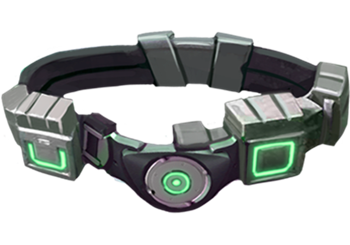 Originally tested in the 23rd Century, the Starfleet Extra Vehicular Activity Atmospheric Containment Field, or Life-Support Belt, was a device that was worn around the waist that generated a specialized atmospheric forcefield around the wearer. Initially, the usage of Life-Support Belts was discontinued due to the likelihood that any failure could result in the user's deaths; however, due to technological advancements, the Life-Support Belt has returned to active duty.
Originally tested in the 23rd Century, the Starfleet Extra Vehicular Activity Atmospheric Containment Field, or Life-Support Belt, was a device that was worn around the waist that generated a specialized atmospheric forcefield around the wearer. Initially, the usage of Life-Support Belts was discontinued due to the likelihood that any failure could result in the user's deaths; however, due to technological advancements, the Life-Support Belt has returned to active duty.Unlike the standard EVA Suit, the Life-Support Belt allows a greater range of motion over the restrictive garment, allowing for fine motor control during repair assignments using tools. Each unit operated by emitting a personal force field around the wearer. When active the device supplied the wearer with the appropriate atmosphere and protected them from the elements that they encountered on their mission. The forcefield was, however, not infallible and was susceptible to Phaser fire. In the event that the forcefield would be disabled, the unit would be penetrated and the user susceptible to danger.
Telefocals
 Similar to pre-spaceflight binoculars, Telefocals allowed for direct visual observation of a subject at range. First employed in the 23rd Century, Telefocals have continued to be used by Starfleet and have been significantly upgraded when compared to the earlier generations.
Similar to pre-spaceflight binoculars, Telefocals allowed for direct visual observation of a subject at range. First employed in the 23rd Century, Telefocals have continued to be used by Starfleet and have been significantly upgraded when compared to the earlier generations.Operating similarly to binoculars on Earth, Telefocals have 50x magnification available to allow observation of a subject at significant distance from the user. Observation functions are supplemented by a built-in rangefinder that gives the user the exact distance of the target from their current location. Unlike earlier models that had to wirelessly attach to a Tricorder, the current generation incorporates sensor technology complimentary to those used within the Tricorder. This allows the Telefocals to conduct both long- and short-range scans on a subject, uncovering both biological, energy, geological, and meteorological data on the target.
Despite being primarily focused on visual inspect, Telefocals are susceptible to many of the same interference complications as the Tricorder. Where the Telefocals are different is that the interference often obstructs views enhanced by sensors, with the interference being translated as false-color images in the Telefocals field of view. Another challenge is that the Telefocals limit the awareness of their user, potentially leading the operator to miss nearby threats.
Security Equipment
Combat Knife
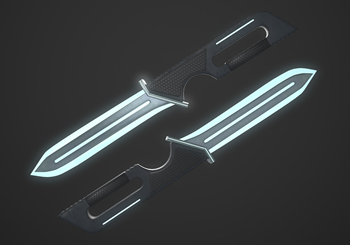 A Combat Knife is a specialized knife designed for mêlée combat. The Combat Knife is standard issue equipment for Starfleet Security, but is not currently assigned to every member of Starfleet.
A Combat Knife is a specialized knife designed for mêlée combat. The Combat Knife is standard issue equipment for Starfleet Security, but is not currently assigned to every member of Starfleet. While energy and projectile weaponry have superseded bladed weapons in destructive power, the Combat Knife has continued to be an effective backup weapon or tool in many militaries. First deployed in 2401, shortly after the 250th Frontier Day, the current generation of Combat Knife is made of an advanced composite alloy and is heavily based upon the knife previously utilized by Starfleet Intelligence forces. Thanks to the composites used in its construction, the Combat Knife is not easily detectable by sensors (unlike Phasers or Disruptor weapons) and is available for close combat situations against opponents. Where the current Starfleet issued Combat Knife excels in comparison to its counterparts in other militaries is that the Starfleet Combat Knife contains an internal charge that can be used to stun an opponent upon contact, making the weapon ideal as a method of disabling rather than killing an enemy.
Grenade
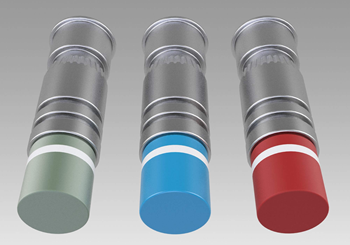 A grenade is a small explosive weapon that is typically thrown by hand or shot from a grenade launcher. Highly restricted within the United Federation of Planets, grenades may only be utilized by Starfleet personnel during times of open war. Each grenade consists of two main sections — a rimmed, cylindrical separating base that fits in the hand of an average-sized humanoid and a metal casing that is topped with a color-coded identifying cap. Their outer casing, which is made of synthetic materials, is designed to detonate either after a time delay or on impact with a target.
A grenade is a small explosive weapon that is typically thrown by hand or shot from a grenade launcher. Highly restricted within the United Federation of Planets, grenades may only be utilized by Starfleet personnel during times of open war. Each grenade consists of two main sections — a rimmed, cylindrical separating base that fits in the hand of an average-sized humanoid and a metal casing that is topped with a color-coded identifying cap. Their outer casing, which is made of synthetic materials, is designed to detonate either after a time delay or on impact with a target. Grenades used by Starfleet are primarily designed to be fired from a Grenade Launcher or from a Mortar, but they may double as a hand grenade in extreme circumstances. When fired from a Phaser Rifle the grenade round has an effective range of 400 meters, and an accurate range of around 180 meters while a Mortar can launch the grenade up to 2 kilometers in any direction. Despite its main purpose as a launched projectile, each grenade can be employed as a hand-thrown grenade by flipping off the plastic cap and depressing the button beneath. This will trigger a three second fuse, after which the round will detonate. Normally, the grenade would be thrown immediately after the safety cap was removed, but could be held for additional time to make the weapon detonate sooner. Presently, no grenade incorporates a safety feature once activated and the detonation will have an equal effect on friend or foe alike.
Grenades | ||
|---|---|---|
| Electromagnetic Pulse | Green | Disables all unshielded technologies in a 15-meter radius of the detonation. |
| Flare | Yellow | Provides illumination for approximately 60 seconds. |
| Forcefield | Blue | Generates a high-powered containment forcefield dome for 5 minutes. |
| Photon | Red | Vaporizes all objects within 5-meter radius of the detonation. |
| Quantum | Purple | Vaporizes all objects within 10-meter radius of the detonation. |
| Stun | Orange | Stuns all Humanoids for 1 hour or a Klingons for 15 minutes in a 10-meter radius of the detonation. |
| Transport Enhancer | White | A beacon that allows a target to be transported through interference. |
| Transport Inhibitor | Black | A beacon that prevents an individual from being transported. |
Security Tricorder Peripheral Module
 While the standard issue Tricorder is all-purpose, powerful sensor devices used by Starfleet and other organizations, there are times where specialty scans and more comprehensive analysis are required as part of an investigation. To better support Starfleet's diverse mission profile, Starfleet Logistical Support has developed specialized Tricorder models to perform enhanced analysis and investigation through the inclusion of a specialty Peripheral Module.
While the standard issue Tricorder is all-purpose, powerful sensor devices used by Starfleet and other organizations, there are times where specialty scans and more comprehensive analysis are required as part of an investigation. To better support Starfleet's diverse mission profile, Starfleet Logistical Support has developed specialized Tricorder models to perform enhanced analysis and investigation through the inclusion of a specialty Peripheral Module. The Tricorder Peripheral Module is a sensor probe that connects with a Tricorder through a remote secure wireless connection, allowing the user to conduct more intensive scans than available with a standard Tricorder. Operated within a minimum distance of five meters from the subject, the closer the user gets to the target the more enhanced scans can be completed. The peripheral can be directly attached to the underside of the Tricorder while not in usage, but must be disconnected from the Tricorder and held in the user's hand to conduct a scan.
The Security Tricorder is a specialized Peripheral Module that has been designed to assist the user in completing security and other special operations. Security Tricorders are optimized to complete forensic analysis, detection of weapon systems, and locating contraband. The specialized sensors of the Security Tricorder can often interface with computer systems, bypassing authorization codes and accessing critical data through the deployment of malware into the system.
Type II Phaser Pistol
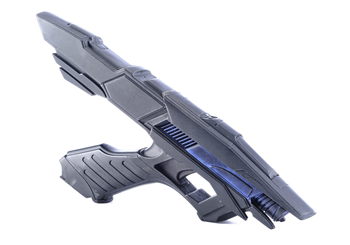 Phasers, short for PHASed Energy Rectification, are the standard defensive weapon used by Starfleet. Constructed of nano-bound polyduranium and other synthetic materials, the current Type II Phaser is an all-in-one unit featuring an industrialized, pistol look that lacks the smaller detachable Type 1 unit that had been incorporated in earlier generations of Phaser. Designed by Starfleet Tactical Specialists on Andoria, Phasers are useful weapons that can also be used as a cutting tool, to heat rock, or remove obstacles.
Phasers, short for PHASed Energy Rectification, are the standard defensive weapon used by Starfleet. Constructed of nano-bound polyduranium and other synthetic materials, the current Type II Phaser is an all-in-one unit featuring an industrialized, pistol look that lacks the smaller detachable Type 1 unit that had been incorporated in earlier generations of Phaser. Designed by Starfleet Tactical Specialists on Andoria, Phasers are useful weapons that can also be used as a cutting tool, to heat rock, or remove obstacles.Operating through the rapid nadion effect (producing highly energetic, short-lived particles) and superconducting crystals to fires concentrated pulses of energy in its default setting, a Phaser can stun most targets at lower settings or cause disintegration at higher levels. Each Phaser can be modified to fire in a beam to conserve power at the expense of range, with further options to fire continuously, in a preprogrammed pattern, or even in a wider arc to impact multiple targets. Internal circuitry continually changes the energy modulation of the Phaser to help prevent an enemy from adapting to a specific frequency.
With an effective range of 100 meters, users of the Phaser can select from one of five power levels through the simplified control interface on the side of the weapon. A Phaser can only be operated by its designated user with their genetic profile programmed into the weapon's memory and are not carried by the Enterprise's crew as standard duty equipment. Should an unauthorized user, even another Starfleet Officer, try to fire a Phaser not assigned to them the weapon will emit a stun pulse to incapacitate them. Normally, Phaser Type IIs may not exceed the stun setting and are closely monitored by the Enterprise's computer for compliance; however, an authorized officer can override to allow higher settings to be used. Further, if enough energy is available, the safety interlocks could be disabled to allow the Phaser to overload, creating an explosive that will detonate 30 seconds afterward.
In previous Type II Phaser Pistols the handgrip of the Phaser was the power cell; however, like the model introduced in 2287, Phaser Pistols aboard the Enterprise have an extractable charging magazine containing the sarium krellide power cell. Inserted into the unit's grip, the angled magazine provides 250 charges prior to needing recharged, with a side mounted ammunition counter showing the remaining number of charges. Personnel could recharge their Phaser through the Enterprise's EPS Taps, or replacement cells could be acquired in the armory. As an optional modification a targeting system could be fitted to aid with targeting, even at long distance.
Phaser Type II Power Settings | |||
|---|---|---|---|
| 1 | Stun | 2 | Stun a Human for 15 minutes or a Klingon for 5 minutes. |
| 2 | Thermal | 5 | Cut a 1 m hole in 10 cm of steel or rock. |
| 3 | Kill | 10 | Kill a humanoid. |
| 4 | Vaporize | 25 | Vaporize any substance. |
| 5 | Disrupt | 50 | Explode 500 cubic meters of rock into rubble. |
| Overload | 100 | Vaporizes all objects within 10 meters of the Phaser. | |
Type III Phaser Rifle
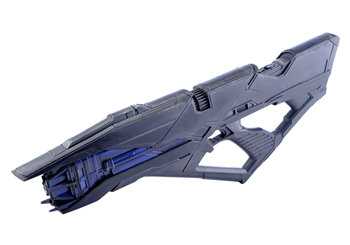 Phasers, short for PHASed Energy Rectification, are the standard weapon used by Starfleet and Starfleet has assigned Type III Phaser Rifles for usage aboard its starships and space stations during times of war or extreme danger. While Type I and II Phasers are classified as defensive weapons, the Phaser Rifle itself is an offensive weapon that is constructed of lightweight nano-bound polyduranium and other synthetic materials allowing it to be carried in one hand. Designed and built on Andoria alongside the Type II Phaser, Phaser Rifles are rarely used except for in situations where combat is anticipated.
Phasers, short for PHASed Energy Rectification, are the standard weapon used by Starfleet and Starfleet has assigned Type III Phaser Rifles for usage aboard its starships and space stations during times of war or extreme danger. While Type I and II Phasers are classified as defensive weapons, the Phaser Rifle itself is an offensive weapon that is constructed of lightweight nano-bound polyduranium and other synthetic materials allowing it to be carried in one hand. Designed and built on Andoria alongside the Type II Phaser, Phaser Rifles are rarely used except for in situations where combat is anticipated. Employing a rapid nadion effect (producing highly energetic, short-lived particles) and superconducting crystals, the Phaser Rifle fires concentrated pulses of energy at a target. Due to Starfleet's experiences with the Borg Collective, despite the Borg having been defeated in 2401, internal circuitry within the rifle continually changes the energy frequency of the Phaser to help prevent an enemy from adapting to a specific modulation. Like its counterparts, usage of the Phaser Rifle is closely monitored by the Enterprise's computer; however, the rifle does not have governor limitations on its power setting due to the selective nature of its deployment. Also, like other Phasers, the Phaser Rifle is fitted with sensors in the grip to ensure the proper operator is using the weapon and will deploy countermeasures of an unauthorized user attempts to use it in a fight. A top mounted ammunition counter monitors the rifle's extractable sarium krellide power cell magazine, showing the remaining amount of the unit's 500 charges available, and has an effective range of 1,000 meters.
Compared to its predecessors, the current model Phaser Rifle features more customization options based upon the mission profile. An extended magazine is available to increase the available charges to 750, while an accelerator module can be used to enhance the rate of fire beyond manufactured limits, but at the expense of higher recoil and ammunition management. The rifle can be fitted with an underslung Grenade Launcher that consists of a barrel, breech and magazine. Fired using a trigger built into the forward grip, Grenades must be hand-loaded into the launcher's four-round magazine, which are then loaded into the breech and primed to fire via pump action. A further modification allows users to replace the grenade launcher with an under barrel mounted 15 round shell launcher that is based upon technology designed for the TR-116 rifle in the 24th Century, allowing the rifle to be used when an operator encounters a dampening field or shielded target.
Additional modifications increase the rifle's abilities in engaging ranged targets. The rifle's accuracy could be improved through the incorporation of a targeting module, which assists the user via a Tricorder module mounted on the rifle. The tracking system could be further enhanced through a specialized stock that could steer the rifle toward the target, but the user could override this by manually directing the rifle to their preferred target. Should the user engage a long-distance target, a state-of-the-art reconnaissance scope capable of identifying and displaying threats as far as 2 kilometers away was available, essentially making the Phaser Rifle into a Sniper Rifle. This mode features additional modifications to suppress the rifle's sound and flash for a better accuracy, but with reduced stopping power.
Phaser Type III Power Settings | |||
|---|---|---|---|
| 1 | Stun | 2 | Stun a Human for 15 minutes or a Klingon for 5 minutes. |
| 2 | Heavy Stun | 3 | Stun a Human for 1 hour or a Klingon for 15 minutes. |
| 3 | Thermal | 5 | Cut a 1 m hole in 10 cm of steel or rock in 3 minutes. |
| 4 | Heavy Thermal | 7 | Cut a 1 m hole in 10 cm of steel or rock in 30 seconds. |
| 5 | Kill | 10 | Kill a humanoid. |
| 6 | Light Disrupt 1 | 15 | Cut a 1 m hole in a duranium bulkhead in 10 minutes. |
| 7 | Light Disrupt 2 | 20 | Vaporize resilient alloy. |
| 8 | Medium Disrupt 1 | 25 | Vaporize any substance. |
| 9 | Medium Disrupt 2 | 35 | Explode 100 cubic meters of rock into rubble. |
| 10 | Heavy Disrupt | 50 | Explode 500 cubic meters of rock into rubble. |
| Overload | 150 | Vaporizes all objects within 15 meters of the Phaser. | |
SIMs Beacon
Powered by an internal battery, many believe that the standard issue SIMs Beacon is little more than a flashlight; however, as with many Starfleet technologies, the SIMs Beacon is in reality a multifunction tool that can be critical for survival. The current SIMs Beacon can be modulated to change the frequency of light emitted from the device, making the unit ideal in survival situations as the light could serve as a source of heat. Other wavelengths could be used to support species that evolved with other types of natural light.